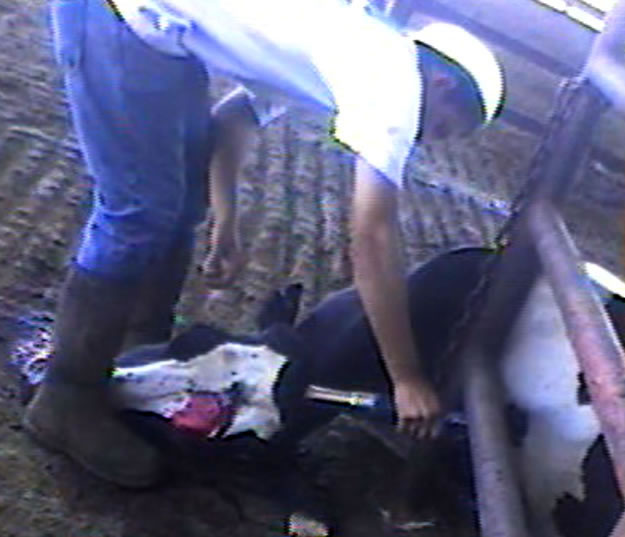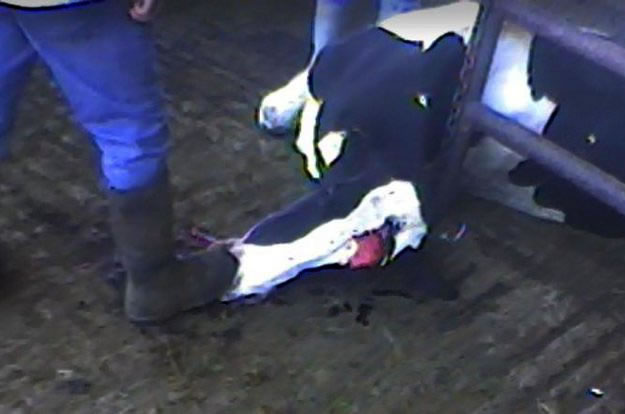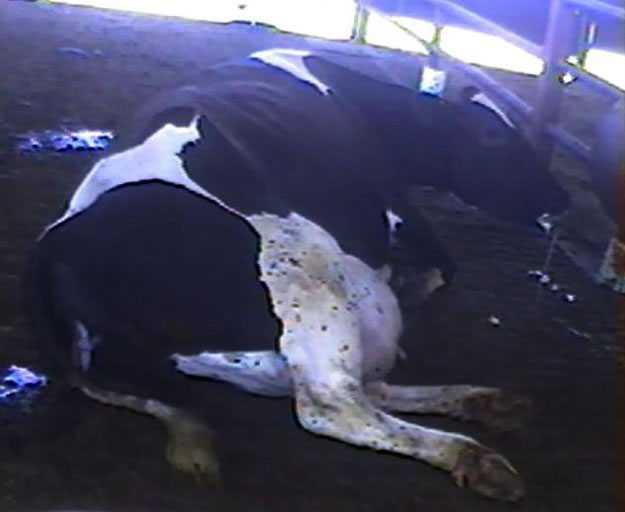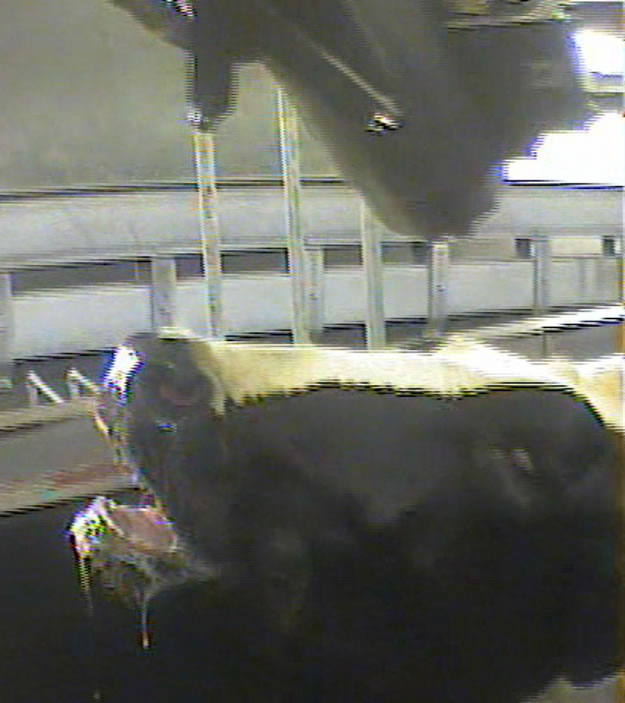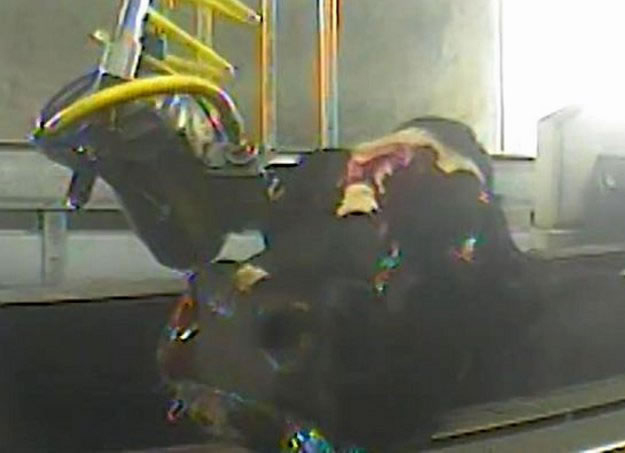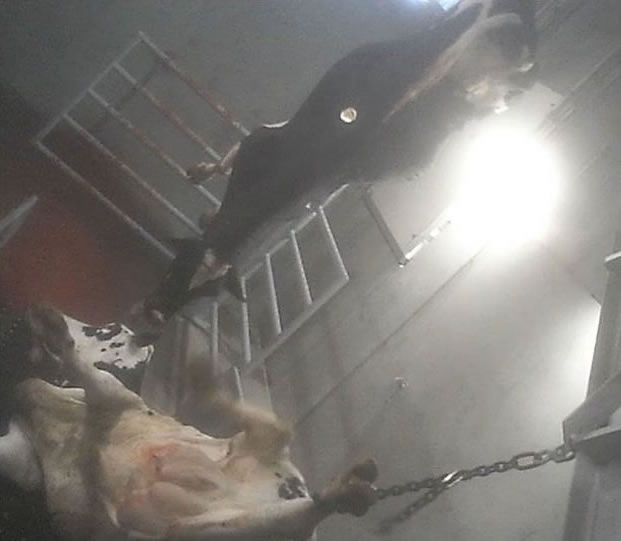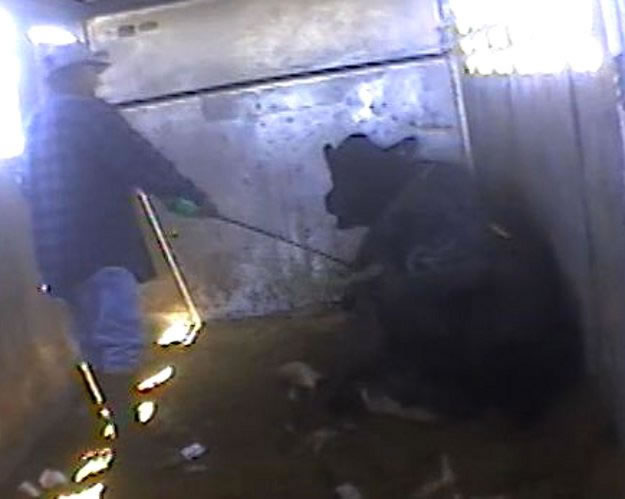Central Valley Meat Shut Down Again by USDA - This Time for Unsanitary Conditions
Video | Photos | Federal & State Laws | Investigator Notes | Press | Act Now | Donate
Animal Outlook’s undercover video prompts USDA to shut down CA slaughterhouse & suspend federal purchases from facility. In-N-Out Burger, Costco and McDonald’s also sever ties.
An undercover video filmed by an Animal Outlook investigator exposes rampant animal abuse and suffering inside Central Valley Meat Co. (CVM), a slaughterhouse in Hanford, California. CVM is a major supplier to the USDA’s National School Lunch Program and other federal food initiatives.
Like all federally inspected slaughterhouses, CVM is required to comply with federal animal welfare requirements as well as California’s animal protection laws. However, Animal Outlook’s whistleblowing video uncovers acts of cruelty that appear to violate both state and federal laws.
After viewing the footage, the USDA shut down the facility, citing “egregious inhumane handling and treatment of livestock.”
In addition to selling meat to the USDA, CVM also supplies major companies, including In-N-Out Burger, a California-based burger chain. In response to this investigation, however, In-N-Out Burger immediately severed ties with CVM.
Animal Outlook has learned that McDonald’s and Costco have also severed supply ties with this facility.
See news coverage: ABC World News, CNN, New York Times, Associated Press, Reuters, Los Angeles Times and UK’s Daily Mail.
Most of the animals slaughtered by CVM are “spent” dairy cows who are no longer economically viable as milk-producers to the dairy industry. It’s shameful – and illegal – that these cows, many of whom are sick or injured, are forced to endure such blatant abuses at the hands of the meat industry. And it’s alarming that this was happening in a USDA-inspected facility with meat from this facility being fed to our nation’s children.
In 2008, the Humane Society of the United States uncovered similar abuses inside Hallmark-Westland, another California dairy cow slaughter plant and USDA supplier. That video revealed violations of state and federal animal welfare requirements and resulted in the largest-ever meat recall in U.S. history.
“I could not believe the repeated Humane Slaughter Violations that occurred… The company… should be held accountable for these violations.”
Lester Friedlander, DVM
Former USDA inspector and supervisor
Central Valley Meat Investigation Photos
The Investigation
The video, filmed by an Animal Outlook investigator who worked at the facility in June and July 2012, documents egregious inhumane treatment, improper slaughter methods and intentional cruelty forced upon these animals in the last moments of their lives:
- Downed cows, unable to walk to the kill floor, shot in the head two, three, even four times, and workers often walking away while the animal continues to struggle and kick.
- Some downed cows who were still alive after being shot in the head were then suffocated by workers who stood on their mouths and nostrils preventing the cows from breathing.
- Cows being tortured – repeatedly hit, jabbed, electrically shocked and sprayed with hot water – in a narrow chute leading to the kill floor. One cow was electrically shocked over 40 times.
- Sick or injured cows repeatedly being shocked and workers pulling or lifting them by their tails in an attempt to force them to stand and walk.
- Improper stunning of animals prior to slaughter – many cows were thrashing kicking, and clearly breathing after being shot in the head. Yet these animals are moved through the slaughter process onto a conveyor belt and then hoisted upside down by one leg.
Sadly, such abuses are not isolated incidents. Numerous undercover investigations inside slaughterhouses throughout the U.S. reveal that animal cruelty is standard practice in the meat industry. More than nine billion animals – birds, pigs and cows – are raised and killed for food each year in the U.S. The most effective way each of us can help end these abuses is to simply leave animals off our plates. Start today: visit TryVeg.com.
Federal and State Laws: Animal Welfare & Food Safety
Animal Outlook’s undercover investigation inside Central Valley Meat reveals what we believe to be numerous violations of federal laws and regulations relating to animal welfare and food safety as well as state anti-cruelty laws.
Our documentation exposes:
- the repeated use of electric prods and physical force (lifting cows by their tails) of animals too sick or injured to walk, commonly referred to in the meat industry as “downers,” in an effort to get them to stand and walk;
- excessive use of electric prods and other devices to force animals to move faster (or in the right direction) in the chutes leading to the kill floor; and
- improper stunning prior to slaughter resulting in animals kicking and struggling as they’re being hoisted by a chain wrapped around one of their legs.
Cows who are too sick or weak to stand or walk on their own have a higher risk of carrying BSE, or mad cow disease. So in 2009, in response to an undercover video exposing extreme abuse inside another California-based meat slaughter plant which led to the nation’s largest-ever meat recall, the federal government permanently banned the slaughter of “downer” cows for human consumption.
In 2009, California also enacted a ban on selling or slaughtering all downed animals (including pigs). Earlier this year, however, after the meat industry sued over the law, the U.S Supreme Court struck down most of the provisions of this state law.
Below are some excerpts from some relevant federal and state laws.
Federal Laws and Regulations
According to the USDA’s Food & Safety Inspection Service (FSIS) Directive on Livestock Inspections 6100.1, rev. 1 (emphasis added):
- “When an establishment offers for slaughter recumbent livestock for ante-mortem inspection, the establishment may help an animal that is capable of rising by providing the animal support (e.g., providing a steadying hand). Such support may not be by mechanical means, nor is the establishment permitted to lift the animal in any way.”
- “The establishment must treat the animal humanely when attempting to have it rise or ambulate. FSIS does not consider forcing an animal to stand or ambulate by kicking or prodding (e.g., electrical prodding) to be humane.”
- “Non-ambulatory disabled cattle are not eligible for slaughter.”
According to the federal Humane Methods of Slaughter Act 7 U.S.C. § 1902 (emphasis added):
- ”No method of slaughtering or handling in connection with slaughtering shall be deemed to comply with the public policy of the United States unless it is humane. Either of the following two methods of slaughtering and handling are hereby found to be humane:
- (a) in the case of cattle … all animals are rendered insensible to pain by a single blow or gunshot or an electrical, chemical or other means that is rapid and effective, before being shackled, hoisted, thrown, cast, or cut; or
- (b) by slaughtering in accordance with the ritual requirements of the Jewish faith or any other religious faith …
The USDA’s FSIS Directive “Humane Handling & Slaughter of Livestock” (6900.2) provides definitions (emphasis added):
- “Egregious inhumane treatment: An egregious situation is any act or condition that results in severe harm to animals, for example:”
- “Excessive beating or prodding of ambulatory or nonambulatory disabled animals or dragging of conscious animals”
- “Stunning of animals and then allowing them to regain consciousness”
- “Multiple attempts, especially in the absence of immediate corrective measures, to stun an animal versus a single blow or shot that renders an animal immediately unconscious”
- “Otherwise causing unnecessary pain and suffering to animals, including situations on trucks.”
- Humane Handling: Handling and slaughter practices that cause a minimum of excitement, pain, injury, or discomfortto livestock.
According to the “Handling of Livestock” regulation under the Humane Methods of Slaughter Act (9 C.F.R. § 313.2) (emphasis added):
- “Driving of livestock from the unloading ramps to the holding pens and from the holding pens to the stunning area shall be done with a minimum of excitement and discomfort to the animals. Livestock shall not be forced to move faster than a normal walking speed.”
- “Electric prods, canvas slappers, or other implements employed to drive animals shall be used as little as possible in order to minimize excitement and injury. Any use of such implements which, in the opinion of the inspector, is excessive, is prohibited.”
According to the “Mechanical, Captive Bolt” regulation under the Humane Methods of Slaughter Act (9 CFR § 313.15):
- “The animals shall be stunned in such a manner that they will be rendered unconscious with a minimum of excitement and discomfort.”
- “The stunning operation is an exacting procedure and requires a well-trained and experienced operator. He must be able to accurately place the stunning instrument to produce immediate unconsciousness.”
California State Law
According to Calif. Penal Code § 597(a) & (b):
- “…every person who maliciously and intentionally maims, mutilates, tortures, or wounds a living animal, or maliciously and intentionally kills an animal … is, for every such offense, guilty of a crime …”
- “…every person who…tortures, torments… cruelly beats, mutilates, or cruelly kills any animal, or causes or procures any animal to be so…cruelly beaten, mutilated, or cruelly killed; and whoever, having the charge or custody of any animal, either as owner or otherwise, subjects any animal to needless suffering, or inflicts unnecessary cruelty upon the animal, or in any manner abuses any animal… is, for every such offense, guilty of a crime…”
Central Valley Meat Investigator’s Log Notes
Each day, after working inside Central Valley Meat and wearing a hidden camera to capture the cruelties routinely taking place behind closed doors, our investigator also wrote daily log notes to further illustrate the misery endured during the last moments of these cows’ lives.
Here are a few excerpts from those log notes:
- “I witnessed a cow who went down and would not get up after being shocked or pushed. I saw a worker shoot the cow in the middle of the forehead. Blood began seeping out of her nose and she thrashed around violently for approximately one minute. He then shot her in the back of the head, between the ears, and she kept moving her legs. He shot her again and told me he usually does three times. She was still breathing when he then put his boot over her nostril and held it there. I asked what that was about and he told me it ‘helps them die faster because they can’t get air.'”
- “While moving the animals into the kill floor door, the manager said ‘Ride the roller coaster, bitches.'”
- “I saw a worker shock a cow about 15 times. She kept trying to get up but then falling back down. She finally got up and walked to the kill floor. The worker said that is why he is the best.”
- “I saw a worker hitting the cows with his flag as if he was hitting balls with a baseball bat. He held the flag with both hands like a bat and swung seemingly as hard as he could and hit the cows. He told me to yell at them, act like it was my husband or my brother or sister.”
- “… I saw that [another worker] was pushing a cow whose left front foot … was flopping everywhere in every direction and she could not put any weight on it. It was oozing bright red fresh blood. As she got closer to me I could see fragments of her bone sticking through the skin.”
Press
- McDonald's, USDA halt buying from Central Valley slaughterhouse Los Angeles Times · August 23, 2012
- AVMA calls dairy cow abuse shown in new video “inhumane and unacceptable” American Veterinary Medical Association · August 22, 2012
- Experts criticize Hanford meat plant practices Fresno Bee · August 22, 2012
- McDonald's Ends Slaughterhouse Buys Associated Press · August 22, 2012
- Work at Slaughterhouse Is Halted After Graphic Undercover Videos New York Times · August 22, 2012
- USDA Suspends Slaughterhouse After Video Appears to Show Animal Cruelty CNN · August 22, 2012
- Central Valley Slaughterhouse Closed Over Inhumane Treatment Los Angeles Times · August 22, 2012
- In-N-Out dumps California slaughterhouse accused of abusing cows Los Angeles Times · August 21, 2012
- Feds close Calif. Slaughterhouse After Abuse Video ABC World News · August 21, 2012
- USDA Closes California Slaughterhouse Over Cow Cruelty Video Reuters · August 21, 2012
- Revealed: Shocking Undercover Video Captures Inhumane Butchering of Cattle at Slaughterhouse for In-N-Out Burger Chain Daily Mail · August 21, 2012
- Feds Close Central Valley Slaughterhouse Associated Press · August 21, 2012
Act Now
Animal Outlook goes undercover inside factory farms to shed a bright light on the cruel and inhumane treatment of farmed animals kept hidden behind the closed doors of animal agribusiness.
The abuses documented at Central Valley Meat are not isolated incidents. Numerous undercover investigations inside slaughterhouses throughout the U.S. reveal that animal cruelty is standard practice in the meat industry. More than nine billion animals – birds, pigs and cows – are raised and killed for food each year in the U.S.

